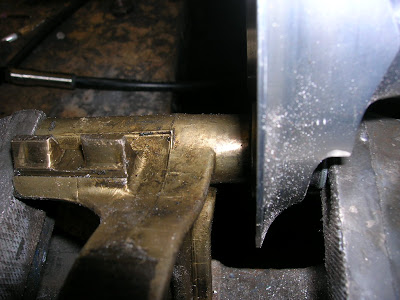Not a fan of normal wheel studs. Advise everyone to swap them. But maybe not quite as extreme as these. Seen to many snapped studs on 185 tyres and trackcars!
The normal 3/8th stud is often barely engaging the wheel on some alloys with a thick mounting flange, not even a full nuts worth of thread.
If running steel wheels these studs may not be suitable as the flange protrudes from the hub by about the thickness of the wheel body. You could easily fix that by removing 2 threads from the wheelnut, by drilling them out from the coned end. Or sourcing studs with a small flange.
Also the seating area of these studs are bigger than normal, the heads do not fit in the chamfer as normal, but rest on the flat area around the chamfer, you may need to just open out the inner most area of the hub around the unused chamfer, just behind each stud head on the inner most area of the studs seating plane, just to get a flat area the stud can evenly sit on...About 5seconds with a dremel and a sanding wheel. This needs to be done on the alloy and steel hubs.
These are good old Ford studs, Escort, Capri etc.
Spline diameter 13.1mm
Thread M12x1.5.
Length 67mm.
http://www.rallydesign.co.uk/catalog/product_info.php?cPath=731_735&products_id=4675
or:
http://www.rallydesign.co.uk/catalog/product_info.php?cPath=731_735&products_id=4674
To fit them is easy.
Remove the old studs first.
Simply use a PRESS onto the end of the studs you are removing and an old piston gudgeon pin or piece of hollow bar that is big enough to slide over the HEAD of the stud behind it. You may need to adjust 1/4 of the bar or pin adding a chamfer, so it seats FLAT on the hub, this adjusted area runs on the inner most part of the stud seat where there is not much room.
VERY important the hub is at 90degrees to the press at all times and the stud is inline, perfectly, unless you want a wrecked hub.
Press the stud down inside of the pin/bar. Make damn sure you press them out straight. The ones in these alloy hubs were VERY tight, no way you'd remove without a press without breaking something, it took 4 tonnes to remove them, scary stuff!
Also a press loads only the area behind the stud etc the pin/hollow bar is sat on and no load through the hubs as a whole, as such. With an expensive part it pays to work in the right methods!

Place a decent LARGE hard washer between the bar and hub face, or in this case whatever was to hand, an old gearbox fork, so a washer between the gearbox form and the hub, unless you want to wreck the hub and leave BIG ring of indentation.
Place another washer between the head of the stud and vice jaws about 2mm thick. Make sure the vice jaws will not bite into the hub and inspect clearance all around the hub at the back. Once satisfied, stick the breaker bar on the vice handle and wind the stud in.
Due to the stiffness of the old studs when fitted, in this case I had remove some pushthrough alloy from the outer end (wheel end) of the stud holes, where the teeth on the old studs had pushed a lip of material outward when they were fitted cause the triumph stud has a very minor flange chamfer so material travels with the stud when fitted, outward. This needed dressing back (dremel with a small sanding wheel, very DELICATE) before I was happy to push the studs in as they were also nice and tight.
I loaded the holes with loctite before these studs went in. You really don't want to screw this job up, proceed with extreme caution, cause the alloy hubs will probably only take new studs being fitted a few times. You press one out off centre, or fit one wonky you will DO major damage, unlike steel, you might need a trip to a TIG welder and find yourself redoing a stud hole.
All in all not a major job, only 2hrs!
Caution and patience a major priority, if in doubt or worried, as this case, leave it to someone who has done it before.
On steel hubs, much less to worry about!
You are now ready for some safe hard motoring and trackdays on wide rubber.
I also had to remove some bash marks from the outer edge of the hubs, raised divots could cause a wheel to run out of true etc...especially an Alloy one with a big seat area.
Thursday, January 03, 2008
Uprated / Uprating Triumph Spitfire GT6 wheel studs
Posted by
David Powell
at
10:56 PM
![]()
![]()
Subscribe to:
Post Comments (Atom)
No comments:
Post a Comment